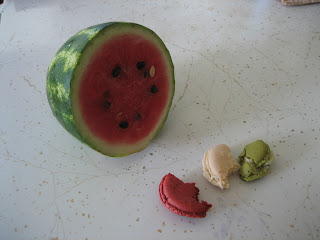Here you go. A trunk full of squashes and pumpkins (all in the pumpkin family). Great thing about pumpkins is that they can sit in a dark cool place for a long while, and then I eventually make them into pies!
Since we are here to find healthy food, it is quite possible to make a healthy pumpkin pie. Just don't use cream or evaporated milk. I use whole milk. Cut your sugar as well in the recipe, which makes the difference between healthy and unhealthy.
Pumpkins are a decent source of fiber and beta carotene. This will help your #2 (remembering going 3 times a day is normal! Fewer toxins in the body also means healthier organs). And, the flavor of fresh pumpkin is deliciously fresh and healthy even on its own. Pumpkin does have some natural sugar content.
Here's a photo of it mashed up. Look at that AMAZING color. Chock-full of beta carotene.
I found a really great recipe on www.pickyourown.org that I use as my base when making fresh pumpkin pie (not from a can). My pumpkins end up in a beautiful pie, pictured here.
Fresh Pumpkin Pie Recipe from Scratch
Ingredients
- a pie pumpkin (see step 1; you can use different types of pumpkin or even a butternut squash)
- 1 cup sugar (see step 10 for alternatives) (metric: 200 grams) [Findfoodlove cuts by at least 50%]
- 1.5 teaspoon ground cinnamon (metric: 3.8 grams)
- 1 teaspoon ground cloves (metric: 2 grams)
- 1 teaspoon ground allspice (metric: 2 grams)
- 1/2 teaspoon ground ginger (metric: 1.25 grams)
- 1/2 teaspoon of vanilla extract (optional) (metric: 20 grams)
- 1/2 teaspoon salt (optional, I don't use any)
- 4 large eggs
- 3 cups pumpkin glop (ok... "sieved, cooked pumpkin") (metric: 0.7 litre)
- 1.5 cans (12oz each) of evaporated milk [Findfoodlove uses whole milk, and I put in less than their 1.5 cans. I eyeball it, sorry no measurements]
If you can't get canned evaporated milk, make your own from nonfat dried milk and make it twice as concentrated as the directions on the box call for!
If you can't get nonfat dried milk, just use milk.
If you are lactose-intolerant, use lactose-free milk or soy milk.
One visitor tried fresh whipping cream (unwhipped) and reported the pie "turned out wonderful! "
Another suggests using coconut milk, if you are allergic to dairy.
Note: If you can't get evaporated milk, you can substitute nonfat dried milk - make it twice as concentrated as the directions on the box say to reconstitute it. It won't be the same as evaporated milk, but it ought to come close.
For directions and the original recipe: Pumpkin Pie recipe found on pickyourown.org




